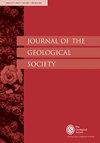Cenozoic sedimentary evolution of the Tiereke section on the northern Tarim Basin: implications for the intracontinental mountain building of the Eastern Tian Shan
IF 3
3区 地球科学
Q2 GEOSCIENCES, MULTIDISCIPLINARY
引用次数: 1
Abstract
The Tian Shan is one of the world's largest intracontinental orogens and provides an excellent example for deciphering the intracontinental responses to the tectonics of plate boundaries. Despite its significance, the timing and driving mechanism of the Cenozoic mountain building of the Tian Shan in the context of the India-Eurasia collision remain controversial. In this study, Cenozoic stratigraphy of the Tiereke section along the western Kuqa Depression of the northern Tarim Basin on the south foreland of Eastern Tian Shan (east of 80°E) has been investigated. The results indicated that the Cenozoic deposition of the Tiereke region sequentially experienced a transgression from the Kumugeliemu Group to the Suweiyi Formation and a regression from the Suweiyi to the Kuqa Formations. Based on the contact relationships and conglomerate textures, three stages of high-energy alluvial deposition have been identified in the lower Kumugeliemu Group, upper Jidike, and Kangcun-Kuqa Formations, respectively. These sedimentary events were interpreted to represent phases of Eastern Tian Shan mountain building at ca. 54 Ma, ca. 27 Ma and since ca. 9.7 Ma according to previous magnetostratigraphic results, which were possibly related to the initial India-Eurasia collision, the collision between the India and Tarim lithospheric mantles, and the basinward propagation of deformation, respectively. Thematic collection: This article is part of the Mesozoic and Cenozoic tectonics, landscape and climate change collection available at: https://www.lyellcollection.org/topic/collections/mesozoic-and-cenozoic-tectonics-landscape-and-climate-change塔里木盆地北部铁尔克剖面新生代沉积演化:对东天山陆内造山的启示
天山是世界上最大的陆内造山带之一,为解读陆内对板块边界构造的响应提供了一个很好的例子。尽管具有重要意义,但在印度-欧亚碰撞背景下,新生代天山造山的时间和驱动机制仍存在争议。本文对东天山南前陆(80°E以东)上沿塔里木盆地北部库车坳陷西部的铁勒克剖面进行了新生代地层研究。结果表明,铁热克地区新生代沉积经历了从库穆格列木群到苏潍依组的海侵和苏潍依组到库车组的退变。根据接触关系和砾岩结构,确定了库穆格列木组下段、吉代克组上段和康村—库车组3期高能冲积沉积。根据前人的磁地层学结果,这些沉积事件分别代表了约54 Ma、27 Ma和约9.7 Ma以来的东天山造山阶段,可能与最初的印度-欧亚碰撞、印度-塔里木岩石圈地幔碰撞和变形向盆地传播有关。专题文集:本文是中生代和新生代构造、景观和气候变化文集的一部分,可在https://www.lyellcollection.org/topic/collections/mesozoic-and-cenozoic-tectonics-landscape-and-climate-change上找到
本文章由计算机程序翻译,如有差异,请以英文原文为准。
求助全文
约1分钟内获得全文
求助全文
来源期刊

Journal of the Geological Society
地学-地球科学综合
CiteScore
6.00
自引率
3.70%
发文量
68
审稿时长
6-12 weeks
期刊介绍:
Journal of the Geological Society (JGS) is owned and published by the Geological Society of London.
JGS publishes topical, high-quality recent research across the full range of Earth Sciences. Papers are interdisciplinary in nature and emphasize the development of an understanding of fundamental geological processes. Broad interest articles that refer to regional studies, but which extend beyond their geographical context are also welcomed.
Each year JGS presents the ‘JGS Early Career Award'' for papers published in the journal, which rewards the writing of well-written, exciting papers from early career geologists.
The journal publishes research and invited review articles, discussion papers and thematic sets.
 求助内容:
求助内容: 应助结果提醒方式:
应助结果提醒方式:


